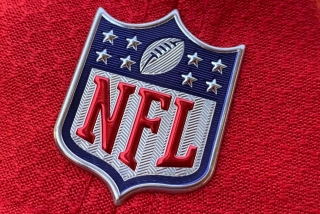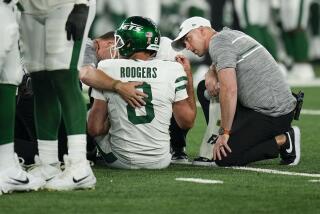NFL Players’ Use of Steroids Causes a Heavy Debate
- Share via
Only in the past three years has the National Football League begun to deal in an official way with The Steroid Question. Testing for steroid use began in 1987, and definite penalties were instituted for the first time by Commissioner Pete Rozelle in a letter to NFL players and prospective draft picks last March 31. For the first time, the NFL is on record in support of the position that steroids are a health risk that give those who are taking them a competitive advantage.
The new policy against steroids, however, isn’t likely to make them go away overnight after more than 30 years of use by elite athletes in a variety of sports. If anything, the debate over their use is more intense than ever. And despite NFL test results that put use in the range of 6% to 7%, several players have estimated use at between 50% and 75% among players at the strength positions on the offensive and defensive lines and at linebacker.
Obviously, the athletes believe steroids enhance their performance ability and are worth the health risk when the reward is a professional contract. In the context of that environment, the forces that favor continued research and supervised use of steroids may be described as the realists who believe steroids are here to stay. Those who argue for the elimination of steroids and a return to a “level playing field” in which competitors rely only on their natural physical talents think of themselves as idealists.
Continued advancements in steroid use are inevitable, say the realists. The athletes always are one step ahead of the testers, although it seems the technological gap is closing. Random testing could detect most steroid use, but announced testing dates enable users to time their cycles of use. The pharmaceutical company that invents a designer steroid capable of avoiding detection would make a fortune in what is estimated to be a $500 million annual business in America.
“The government is spending money on enforcement of laws against the illegal distribution of steroids,” said Jim Wright, an exercise physiologist who has written several papers on steroid research and is regarded as one of the most knowledgeable authorities in the United States. “But they can’t control cocaine, marijuana or anything. Some gym pushers and medium-level distributors get burned, but the government can’t legislate morality.”
Comparing anti-steroid publicity to an old film on the dangers of marijuana use, Wright added, “The health hazards have been overstated, just like in ‘Reefer Madness.’ They’re creating a credibility gap. A lot of it has to do with the ambivalence of society toward the use of drugs.”
Wright considers himself a realist on the subject of steroid use. He acknowledges some health risks but is convinced they may be minimized with more research and careful supervision of athletes who get most of their information by word of mouth in the gym, underground publications and through experimentation. A former powerlifter who says he never has used steroids, Wright has published two books on steroids and has written a third, and he has served as an information exchange for steroid importers, dealers and athletes.
“It’s not like I provide medical advice,” said Wright, whose doctorate is in zoology, “but I’ve had a lot of people call me about problems they’ve had.”
On the other side of the fence from Wright is Kim Wood, the strength coach of the Cincinnati Bengals. Wood is outspoken in his opposition to steroid use and is a regular contributor to strength-training publications that share that stand.
“(The Bengals) don’t want somebody who is screwed up on drugs because they’re sick, and it’s a similar situation with steroids,” Wood said. “A player on steroids is like a sweater unraveling. What if he only lasts five years because his blood pressure is screwed up and his liver is screwed up? Talent is so high-priced; it has to be seen as an investment.
“But some (football players using steroids) are going to bring in the Dr. Strangeloves, the celebrity chemists, and get strong and try to beat the test. This spy-versus-spy stuff gets a heck of a lot more complex. I’m talking about real dangerous people who don’t care about the athlete’s health, like in track and the Olympics. People who are in doubt about their ability want to take it.”
Wood is an idealist who believes that, in the long run, steroids cause football players to break down and to wear out late in games because their bodies can’t cool fast enough. “What you gain in strength, you lose in health,” Wood said.
Connective tissue often gives way under the strain of steroid-enhanced muscles, and improved strength doesn’t mean a player’s football skills will improve. Wood points to tackle Anthony Munoz and nose tackle Tim Krumrie, both of whom have represented the Bengals in the Pro Bowl, as proof that an athlete can become the best without taking steroids.
More to Read
Go beyond the scoreboard
Get the latest on L.A.'s teams in the daily Sports Report newsletter.
You may occasionally receive promotional content from the Los Angeles Times.










